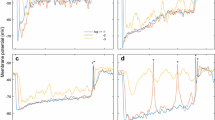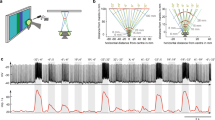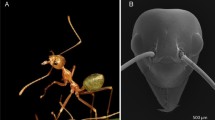Summary
-
1)
Comparable to the bee, but in contrast to the majority of ants, the desert antCataglyphis bicolor has been shown to exhibit a highly developed repertoire of visually guided behavioural responses. This paper deals with the anatomy and fine structure of the peripheral visual pathway of this ant.
In the first visual neuropile, the lamina, first and second order neurons are classified by applying Golgi methods adapted for electron microscopy. Synaptic connections within the lamina are described and discussed. The results are summarised in developing a three-dimensional model of the ant's lamina (Fig. 17).
-
2)
Eachretinula within the central eye region is composed of four large (nos. 2, 4, 6 and 8) and four small retinular cells (nos. 1, 3, 5 and 7) and a basal ninth cell. Visual cells nos. 2, 3, 4, 6, 7, and 8 form short unbranched axons (Rs), which terminate within the lamina. The visual cells nos. 1 and 5 (Rl), as well as the basal cell no. 9, show arborisations in the lamina, but terminate in the second visual neuropile, the medulla. Within the lamina all nine retinular cell axons, originating from one retinula, form a cartridge within which they interact with the second order neurons, the monopolar cells.
Collaterals of second order neurons and side branches of retinular cell axons form local neuronal circuits.
-
3)
Five types ofmonopolar cells have been classified by means of their dendritic fields within the lamina and the medulla (L1a, b, c, L2 and L4). They relay the retinular cells with higher order neurons within the medulla. In the distal layer of the lamina (stratum A) the spreads of the monopolar cells are restricted to a single cartridge, whereas in the proximal stratum C their collateral processes extend laterally through more than one cartridge. The collaterals of the L4-type of monopolar cells are exclusively confined to stratum C. There they are arranged bilaterally along the dorsoventral axis of the eye.
Within stratum A, where all neurons are organised in well defined columns (cartridges), the axons of the short visual cells seem to be distributed over any cross section of a cartridge at random. In this layer, tangential fibres are the only candidates for inter-cartridge cross talk. In stratum C, the columnar organisation of the neuropile becomes less obvious because of the wide spread ramifications of the second order neurons. For instance, the collaterals of the L1a-type of monopolar cell extend over up to 18 neighbouring cartridges.
-
4)
Three types ofcentrifugal fibres running from the medulla to the lamina are observed (T-fibres). Some of them form wide field arborisations either in stratum A (type T2) or in stratum C (type T3). In linear scale, their collaterals may extend over more than 40% of the large (dorsoventral) axis of the lamina.
-
5)
Receptor terminals, especially Rs-fibres, are densely packed with elongated synaptic vesicles, whereas in second order neurons round vesicles are arranged around the presynaptic elements. Especially in Rs-fibres analyses of serial sections reveal T-shaped synaptic ribbons, which are the presynaptic sites as regards four postsynaptic elements. In case of rod-like presynaptic elements diadic and triadic arrangements of postsynaptic fibres can also be observed.
Four main types of synaptic configurations are discriminated: (1) Receptor terminals synapse on second order neurons. (2) Second order neurons synapse on receptor cell axons as well as on other second order profiles. These synapses are sometimes observed in feedback configurations. (3) Synapses occuring between receptor axon terminals. (4) A small, probably efferent neurosecretory nerve fibre synapses on second order neurons. Neurosecretory fibres of larger diameters (to 1.5 Μm are frequently found in stratum C.
Similar content being viewed by others
References
Armett-Kibel, C., Meinertzhagen, I.A., Dowling, J.E.: Cellular and synaptic organization in the lamina of the dragon-fly Sympetrum rubicundulum. Proc. R. Soc. Lond. B.196, 385–413 (1977)
Barlow, R.B., Bolanowski, S.J.: Efferent mediated circadian changes in the neural activity of the Limulus lateral eye. Invest. Ophtal.16, 120 (1977)
Beattie, T.M.: Histology, histochemistry and ultrastructure of neurosecretory cells in the optic lobe of the cockroach Periplaneta americana. J. Insect Physiol.17, 1843–1855 (1971)
Blackstadt, T.W.: Electron microscopy of golgi preparations for the study of neuronal relations. In: Contemporary research methods in neuroanatomy (W.J.H. Nauta, S.O.E. Ebesson, eds.), pp. 186–216. Berlin-Heidelberg-New York: Springer 1970
Boschek, C.B.: On the fine structure of the peripheral retina and lamina ganglionaris of the fly, Musca domestica. Z. Zellforsch.118, 369–409 (1971)
Braitenberg, V.: Patterns of projection in the visual system of the fly. I. Retina-lamina projections. Exp. Brain Res.3, 271–298 (1967)
Braitenberg, V., Debbage, P.: A regular net of reciprocal synapses in the visual system of the fly Musca domestica. J. comp. Physiol.90, 25–31 (1974)
Brunnert, A., Wehner, R.: Fine structure of light- and dark-adapted eyes of desert ants, Cataglyphis bicolor (Formicidae, Hymenoptera). J. Morph.140, 15–30 (1973)
Buchner, E.: Elementary movement detectors in an insect visual system. Biol. Cybernetics24, 85–101 (1976)
Burkhardt, W., Braitenberg, V.: Some peculiar synaptic complexes in the first visual ganglion of the fly, Musca domestica. Cell Tiss. Res.173, 287–308 (1976)
Cajal, S.R., Sanchez, D.: Contribution al conocimiento de los centros nerviosos de los insectos. Trab. Lab. Invest. Biol. Univ. Madrid13, 1–164 (1915)
Campos-Ortega, J.A., Strausfeld, N.J.: Synaptic connections of intrinsic cells and basket arborizations in the external plexiform layer of the fly's eye. Brain Res.59, 119–136 (1973)
Chappell, R.L., Dowling, J.E.: Neural organization of the median ocellus of the dragonfly. I. Intracellular electrical activity. J. Gen. Physiol.60, 121–147 (1972)
Chi Che, Carlson, S.D.: Close apposition of photoreceptor cell axons in the house fly. J. Insect Physiol.22, 1153–1157 (1976)
Colonnier, M.: The tangential organization of the visual cortex. J. Anat. (Lond.)98, 327–344 (1964)
De Robertis, E.: Subcellular distribution of neurohumors and chemical receptors in the central nervous system. J. Neuro-Visceral Rel., Suppl.9, 261–276 (1969)
Duelli, P.: The relation of astromenotactic and anemomenotactic orientation mechanisms in desert ants, Cataglyphis bicolor (Formicidae, Hymenoptera). In: Information processing in the visual systems of arthropods (R. Wehner, ed.), pp. 281–286. Berlin-Heidelberg-New York: Springer 1972
Duelli, P.: A fovea for e-vector orientation in the eye of Cataglyphis bicolor (Formicidae, Hymenoptera). J. comp. Physiol.102, 43–56 (1975)
Duelli, P., Wehner, R.: The spectral sensitivity of polarised light orientation in Cataglyphis bicolor (Formicidae, Hymenoptera). J. comp. Physiol.86, 37–53 (1973)
Elofsson, R., Klemm, N.: Monoamine-containing neurons in the optic ganglia of crustaceans and insects. Z. Zellforsch.133, 475–499 (1972)
Elofsson, R., NÄssel, D., Myhrberg, H.: A catecholaminergic neuron connecting the first two optic neuropiles (lamina ganglionaris and medulla externa) of the crayfish Pacifastacus leniusculus. Cell Tiss. Res.182, 287–297 (1977)
Fahrenbach, W.H.: The morphology of the Limulus visual system V. Protocerebral neurosecretion and ocular innervation. Z. Zellforsch.144, 153–166 (1973)
Fleissner, G., Schliwa, W.: Neurosecretory fibres in the median eyes of the scorpion, Androctonus australis L. Cell Tiss. Res.178, 189–198 (1977)
Hafner, G.S.: The neural organization of the lamina ganglionaris in the crayfish: A golgi and EM study. J. comp. Neurol.152, 255–280 (1973)
Hafner, G.S.: The ultrastrueture of retinula cell endings in the compound eye of the crayfish. J. Neurocytol.33, 295–311 (1974)
Hámori, J., Horridge, G.A.: The lobster optic lamina. II. Types of synapse. J. Cell Sci.1, 257–270 (1966)
Herrling, P.L.: Topographische Untersuchungen zur funktionellen Anatomie der Retina von Cataglyphis bicolor Fabr. (Formicidae, Hymenoptera). Dissertation UniversitÄt Zürich (1975)
Herrling, P.L.: Regional distribution of three ultrastructural retinula types in the retina of Cataglyphis bicolor Fabr. (Formicidae, Hymenoptera). Cell Tiss. Res.169, 247–266 (1976)
Hökfelt, T.: Invitro studies on central and peripheral monoamine neurons at the ultrastructural level. Z. Zellforsch.91, 1–74 (1968)
Karnovsky, M.J.: A formaldehyde-glutaraldehyde fixative of high osmolarity for the use in electron microscopy. J. Cell. Biol.27, 137A-138A (1965)
Kien, J., Menzel, R.: Chromatic properties of interneurons in the optic lobes of the bee. II. Narrow band and colour opponent neurons. J. comp. Physiol.113, 35–53 (1977)
Knowles, F.G.W.: Neuronal properties of neurosecretory cells. In: “Neurosecretion” IV International symposium in neurosecretion (F. Stutinsky, ed.), pp. 8–19. Berlin: Springer 1967
Kretz, R.: Verhaltensphysiologische Analyse des Farbensehens der Ameise Cataglyphis bicolar (Formicidae, Hymenoptera). Dissertation UniversitÄt Zürich (1977)
Kretz, R.: A behavioural analysis of colour vision in the ant Cataglyphis bicolor (Formicidae, Hymenoptera). J. comp. Physiol. (in press, 1979)
Laughlin, S.B.: Neural integration in the first optic neuropile of dragonflies. I. Signal amplification in dark-adapted second order neurons. J. comp. Physiol.84, 335–355 (1973)
Laughlin, S.B.: Neural integration in the first optic neuropile of dragonflies. III. The transfer of angular information. J. comp. Physiol.92, 377–396 (1974)
Laughlin, S.B.: The function of the lamina ganglionaris. In: The compound eye and vision of insects. (G.A. Horridge ed.), pp. 341–358. Oxford: Clarendon Press 1975
Laughlin, S.B.: Adaptations of the dragonfly retina for constant detection and the elucidation of neural principles in the peripheral visual system. In: Neural principles in vision (F. Zettler, R. Weiler, eds., pp. 175–193. Berlin-Heidelberg-New York: Springer 1976
Luft, J.H.: Improvements in epoxy resin embedding methods. J. biophys. biochem. Cytol.9, 409–414 (1961)
Menzel, R.: Spectral sensitivity of monopolar cells in the bee lamina. J. comp. Physiol.93, 337–346 (1974)
Menzel, R., Blakers, M.: Colour receptors in the bee's eye morphology and spectral sensitivity. J. comp. Physiol.108, 11–33 (1976)
Menzel, R., Lange, G.: Änderung der Feinstruktur im Komplexauge von Formica polyctena bei der Helladaptation. Z. Naturforsch.26B, 357–359 (1971)
Menzel, R., Snyder, A.W.: Polarized light detection in the bee, Apis mellifera, J. comp. Physiol.88, 247–270 (1974)
Meyer, E.P.: Strukturanalyse der Neurone I. und II. Ordnung in Sehsystem der Ameise Cataglyphis bicolor (Formicidae, Hymenoptera). Dissertation UniversitÄt Zürich (1976)
Moring, J.: Spectral sensitivity of monopolar neurons in the eye of Calliphora. J. comp. Physiol.123, 335–338 (1978)
Myhrberg, H.: Ultrastructural localization of monoamines in the epidermis of Lumbricus terrestris (L.). Z. Zellforsch.117, 139–154 (1971)
NÄssel, D.R.: The organization of the lamina ganglionaris of the prawn, Pandalus borealis (Kröyer). Cell Tiss. Res.163, 445–464 (1975)
NÄssel, D.R.: The retina and retinal projection on the lamina ganglionaris of the crayfish, Pacifastacus leniusculus (Dana). J. comp. Neurol.167, 341–360 (1976)
NÄssel, D.R.: Types and arrangements of neurons in the crayfish optic lamina. Cell Tiss. Res.179, 45–75 (1977)
Rakic, P.: Local circit neurons. Neurosciences Res. Prog. Bull. 13/3, 291–446 (1975)
Ralston, H.J.: Evidence for presynaptic dendrites and proposal for their mechanism of action. Nature230, 585–587 (1971)
Reimer, L.: Elektronenmikroskopische Untersuchungs- und PrÄparationsmethoden. Berlin-Heidelberg-New York: Springer 1967
Ribi, W.A.: Neurons in the first synaptic region of the bee, Apis mellifera. Cell Tiss. Res.148, 277–286 (1974)
Ribi, W.A.: The neurons of the first optic ganglion of the bee, Apis mellifera. Adv. Anal, Embryol. and Cell Biol.50, 1–43 (1975a)
Ribi, W.A.: Golgi studies of the optic ganglion of the ant, Cataglyphis bicolor. Cell Tiss. Res.160, 207–217 (1975b)
Ribi, W.A.: Fine structure of the first optic ganglion (lamina) of the cockroach, Periplaneta americana. Tissue and Cell9, 57–72 (1977)
Shaw, S.R.: Interreceptor coupling in ommatidia of drone honeybee and locust compound eyes. Vis. Res.9, 999–1029 (1969)
Shepherd, G.M.: The neuron doctrine: a revision of functional concepts. Yale J. Biol. Med.45, 584–599 (1972)
Stell, W.K.: Correlation of retinal cytoarchitecture and ultrastructure in golgi preparation. Anat. Rec.153, 389–398 (1965)
Stell, W.K.: The structure and relationships of horizontal cells and photoreceptor-bipolar synaptic complexes in goldfish retina. Am. J. Anat.121, 401–424 (1967)
Strausfeld, N.J.: Golgi studies on insects. Part II. The optic lobes of diptera. Phil. Trans. R. Soc. London258B, 135–223 (1970a)
Strausfeld, N.J.: Variations and invariants of cell arrangements in the nervous systems of insects. (A review of neuronal arrangements in the visual system and corpora pedunculata.) Verh. Dtsch. Zool. Ges.64, 97–108 (1970b)
Strausfeld, N.J.: The organization of the insect visual system (light microscopy). I. Projections and arrangements of neurons in the lamina ganglionaris of diptera. Z. Zellforsch.121, 377–441 (1971)
Strausfeld, N.J.: Atlas of an Insect Brain. Berlin-Heidelberg-New York: Springer 1976
Strausfeld, N.J., Campos-Ortega, J.A.: The L4 monopolar neuron: a substrate for lateral interaction in the visual system of the fly, Musca domestica. Brain Res.59, 97–117 (1973)
Tisdale, A.D., Nakajima, Y.: Fine structure of synaptic vesicles in two types of nerve terminals in crayfish stretch receptor organs: Influence of fixation methods. J. comp. Neurol.165, 369–386 (1976)
Tranzer, J.P., Richards, J.G.: Ultrastructural cytochemistry of biogenic amines in nervous tissue: Methodologic improvements. J. Histochem. Cytochem.24, 1178–1193 (1976)
Trujillo-Cenoz, O.: Some aspects of the structural organization of the intermediate retina of dipterans. J. Ultrastruct. Res.13, 1–33 (1965)
Trujillo-Cenoz, O.: The structural organization of the compound eye in insects. In: Physiology of photoreceptor organs. Handbook of Sensory Physiology, Vol. II/2 (M.G.F. Fuortes, ed.), pp. 5–62. Berlin-Heidelberg-New York: Springer 1972
Wehner, R.: Die Konkurrenz von Sonnenkompass- und Horizontmarken-Orientierung bei der Wüstenameise, Cataglyphis bicolor (Formicidae, Hymenoptera). Verh. Dtsch. Zool. Ges.16, 238–242 (1970)
Wehner, R.: Structure and function of the peripheral visual pathway in hymenopterans. In: Neural principles in vision (F. Zettler, R. Weiler, eds.), pp. 280–333. Berlin-Heidelberg-New York: Springer 1976
Wehner, R., Duelli, P.: The spatial orientation of desert ants, Cataglyphis bicolor, befor sunrise and after sunset. Experientia (Basel)27, 1364–1366 (1971)
Wehner, R., Flatt, I.: The visual orientation of desert ants, Cataglyphis bicolor, by means of terrestrial cues. In: Information processing in the visual systems of arthropods (R. Wehner, ed.), pp. 295–302. Berlin-Heidelberg-New York: Springer 1972
Wehner, R., Toggweiler, F.: Verhaltensphysiologischer Nachweis des Farbensehens bei Cataglyphis bicolor (Hymenoptera, Formicidae). J. comp. Physiol.77, 239–255 (1972)
Weiler, R., Huber, M.: The significance of different eye regions for astromenotactic orientation in Cataglyphis bicolor (Formicidae, Hymenoptera). In: Information processing in the visual systems of arthropods (R. Wehner, ed.), pp. 287–293. Berlin-Heidelberg-New York: Springer 1972
Author information
Authors and Affiliations
Rights and permissions
About this article
Cite this article
Meyer, E.P. Golgi-Em-study of first and second order neurons in the visual system ofCataglyphis bicolor Fabricius (Hymenoptera, Formicidae). Zoomorphologie 92, 115–139 (1979). https://doi.org/10.1007/BF01001534
Received:
Issue Date:
DOI: https://doi.org/10.1007/BF01001534




